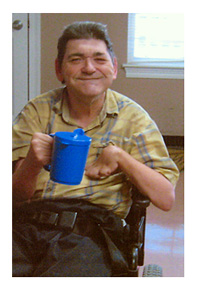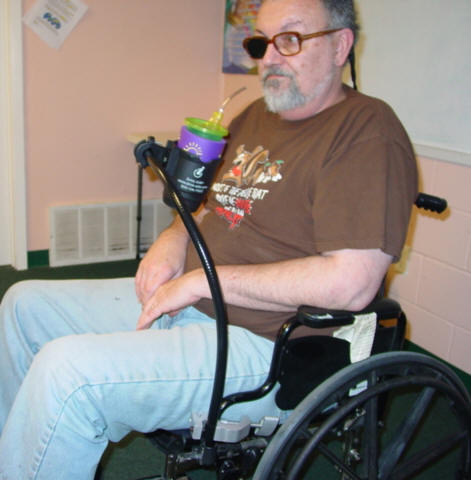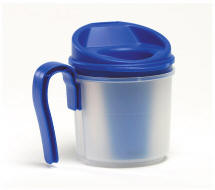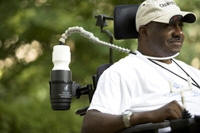Mealtime Partners, Inc.
Specializing in Assistive Dining and Drinking Equipment
January 2011 Independent Eating and Drinking Newsletter
 |
January Topics: |
||
|
Mealtime
Partners Home Page Send a Comment or Suggestion |
|||
Medical treatment for rehydration is estimated to have exceeded $1 billion in the U.S. in 1999 for elderly patients, alone1. If these costs are projected to 2010 it is an enormous medical expense that could be significantly reduced with preventative treatment.
Because medical costs are skyrocketing there is a movement towards providing preventative medical treatment to reduce overall medical cost in the United States. Many health conditions, if treated appropriately on a regular basis, can be managed without hospitalization or the need for emergency treatment, but if neglected can become life threatening. Some examples of these are diabetes, high blood pressure, and some heart conditions. However, something as simple as adequate hydration is often overlooked as a significant health issue that is essential for ongoing good health. When hydration is neglected and someone becomes dehydrated, many negative health issues can occur.
Dehydration is an ongoing problem for many people, especially those with disabilities. It is responsible for health problems such as urinary tract infections, kidney problems, skin tissue deterioration, and headaches. All of these conditions require medical treatment that, in some cases, can be protracted, require hospitalization, and thus be very expensive.
In most cases, dehydration is preventable! However, it takes a vigilant caregiver to offer a drink on a regular schedule to keep someone adequately hydrated. This is a difficult task when someone is undertaking many care-giving responsibilities. Often, what happens is the person is offered a large drink, infrequently. This introduces an element of risk to the health of the person. When drinking a large quantity of liquid at a time, the person drinking takes a sizeable volume of liquid into their mouth at one time, and swallows repeatedly to clear all of the liquid from their mouth. With each swallow, within the sequence of swallows, the risk of choking or aspiration increases. Therefore, because of the added risk, this is a poor method of avoiding dehydration.
For most people a drinking system can be made available to them even if they are unable to hold or lift a cup. However, regardless of this easy solution to avoiding dehydration, Medicare, Medicaid and private health care insurance providers consider all drinking systems as “aids for daily living” and do not cover their cost. However, they do cover the cost of an emergency room visit and/or hospital stay that was brought about by dehydration. According to the Agency for Healthcare Research and Quality (AHRQ)2, about one in ten of the nearly 40 million hospitalizations in 2008 were potentially avoidable. Dehydration was among the conditions for which hospitalization was avoidable with the appropriate outpatient care.
Additionally, according to the National Pressure Ulcer Long-Term Care Study (NPULS)3, dehydration was associated with a 42% increase in risk of developing pressure ulcers in nursing home residents. The estimated annual cost for treating pressure, or decubidus, ulcers in the United States is $1.3 billion.
Would it not be wiser for Medicare, Medicaid and private insurance providers to fund drinking systems for those clients who are unable to drink independently? It certainly appears to be one inexpensive approach for reducing overall medical expenses in the United States.
| Mealtime Partners offers a broad range of drinking systems, some provide hands free drinking and can be mounted to a wheelchair or bed. Others address the special swallowing needs of our clients including drinking thickened liquids or needing a controlled amount of liquid for each swallow. For complete information on all of our drinking systems click here. For additional assistance in deciding which system is most appropriate for your client or family member, call Mealtime Partners, Inc. at 800-996-8607. |
Some of our Drinking Products are pictured below.
| The Thickened Liquids Cup for drinking thickened liquids. | The Front Mounted Drinking System for people with weak suction. | |
 |
 |
|
|
|
||
| The Provale Cup dispenses a controlled amount of liquid for those at risk of choking or aspiration. | The Drink AideTM Drinking System - Discontinued | |
 |
 |
|
| To view our complete line | of | Drinking products, click here. |
How to be a Good Mealtime Partner
What’s in a word?
The definition of a duet is: two performers, musicians or singers, who perform together. In ballet, a pas de deux (translated from French literally means “not two”) is a dance for two people who, by the act of dancing together are “not two” but become one.
On a daily basis, those who need assistance with activities of daily living, like eating and drinking, and their care providers, perform duet after duet. With years of practice they have become experts at working together to complete a function without obstacles interfering with the event. For example, many mothers who feed their children complete meal after meal with both individuals being fed at the same time, with conversation between them, and without stress. This is the ideal situation. However, for many more mealtime partners, meals will always be nerve-racking and hectic because of other factors: other children who also need attention; the person being fed has oral motor limits; swallowing difficulties create the need for a protracted mealtime; or, Mom works outside the home and must hurry meals because time is limited. With all of this to consider, the goal must still be to make meals an enjoyable “duet” for the two participants.
For family members, parents, grandparents and siblings, this is an ongoing desire. For a professional care provider, however, the personal commitment to reaching this goal is not always present. They are not necessarily emotional vested in the same way a relative is. They may not have cared for the individual for very long and thus do not know them well. It is a job that they are doing to earn a living. They are paid to perform a “task”. (The definition of task is a piece of work assigned or done as part of one’s duties.) And, for many paid caregivers it is hard work that is burdensome, sometimes distasteful, for which they are poorly paid, and sometimes their efforts are not appreciated.
For those individuals the following thoughts are presented:
Meals are one of the most time consuming activities undertaken day after day if undertaken at a pace that is appropriate for the average person. However, it is one of the few activities required, when caring for another individual’s needs, where the care provider can sit down, and it is an activity that can be conducted at a relaxed pace, that is, for a properly trained caregiver. It should be viewed as a lull in the days schedule rather than another burden.
It should never be assumed that when a new feeding partner is hired that they will know any more about feeding someone than they learned feeding their own children. They probably will not know any of the good feeding practices discussed below, and certainly will not know the individual preferences of their new employer. Therefore, they must be provided with detailed instructions about how to provide mealtime support to be able to do a good job. To properly imprint a new care provider, proper training must be provided right from their first day on the job. Don’t wait until problems arise, but act proactively by giving directions from the very start to develop the best mealtime partnership.
Feeding partner practices that can help create an enjoyable mealtime are:
-
For the person feeding another person to sit down in a comfortable position before starting the meal. This has several benefits. First, it positions the feeding partner at a height that keeps their arm/hand at a level equal to the other person’s mouth, or a little below it. This promotes a chin tuck (the chin being lower than a right angle to the neck) with each bite of food being offered. Also, the sitting position gives the feeding partner time to take the weight off of their feet and rest a little.
-
After each bite of food has been removed from the utensil, put the utensil down until the person being fed either indicates they are ready for another bite or all chewing and swallowing appears to have stopped. While waiting, the feeding partner can rest their arm on the table to reduce the fatigue factor of feeding someone.
-
For the feeding partner, it is a good idea to have something available to drink while they are providing bites to their partner. This allows them to relax in between serving bites. It also gives them something to do for themselves during the meal, making meals a little bit more enjoyable for them.
-
If the person being fed is not extremely difficult to feed, the feeding partner might even consider eating their own meal at the same time.
-
The feeding partner should watch the person being fed and become familiar with their unique eating patterns. This allows them to set a comfortable pace and offer food according to those observed patterns.
-
The feeding partner should accept that a meal will usually take at least 20 minutes and not try to hurry the person eating. Hurrying places the person being fed at risk of choking. It also increases the likelihood that they will have indigestion or develop gastro esophageal reflux disease.
-
Talk with the person being fed, but don’t expect them to respond when they have food in their mouth. If clear speech is difficult for them, when asking a question, phrase it so a yes or no answer can be provided with a small nod of the head.
-
Do not think that the person being fed has finished their meal if they slow down. As a meal progresses two things happen: the person eating begins to tire, and, their appetite begins to become satiated. In either case, they do not want to eat as quickly.
-
Regardless of how busy you are during meals, do not become impatient. If the pace of the meal starts to cause the feeding partner to become impatient, it might be wise to have more frequent smaller meals that take less time than the normal breakfast, lunch and supper. Instead have a small breakfast, a mid-morning snack, a small lunch, a mid-afternoon snack, and a smaller supper.
Regardless of the final routines that are developed between the two participants in a meal, remember that both people should be patient with each other, to consider the other persons feelings, and to enjoy each meal as a time to relax and break up the daily routine for a while.
As final notes about mealtimes there are other definitions that should be considered: partnership – a cooperative relationship between people who agree to share responsibility for achieving some specific goal; and, partner –one that is united or associated with another in an activity of common interest.
The
Mealtime Partner Dining System was designed
specifically to become a partner to the person eating and facilitate
their being able to eat independently instead of them being fed. The
Mealtime Partner allows people to choose what food they will eat out of
the three bowls that are available on the device and to choose when each
bite of food is served to them. Ultimately, it is a partner that
facilitates mealtime independence, and, it is very patient. Tip of the Month: For
individuals who have eating difficulties, keep the mealtime
environment quiet to allow them to concentrate on their meal. Do
not have a television on that will distract them, and, if you
choose to play music, keep the volume low. Watching television
while eating can cause the person to tilt their head upward and
their head will not be in the optimal position for safe
swallowing. Loud noise can cause the person eating to be
startled or distracted, which can contribute to choking.
Home |
Dining |
Drinking |
Videos |
Products |
Warranty |
Ordering |
Calendar |
FAQ |
Newsletters |
Contact Please send comments and suggestions to
newsletters@mealtimepartners.com Copyright © Mealtime Partners,
Inc. 2011 All rights reserved.
References for the
January 2011 Newsletter:
1. Pershad J. A
systematic data review of the cost of rehydration therapy. Applied
Health Economics and Health Policy. 2010; 8(3): 203-14.
2. Potentially Preventable Hospitalizations for Acute
and Chronic Conditions, 2008 (http://www.hcup-us.ahrq.gov/reports/statbriefs/sb99.pdf).
3. Horn, S. D., Bender, S. A., Bergstrom, N.,
Cook, A. S., Ferguson, M. L., Rimmasch, H. L., Sharkey, S. S., Smout, R.
J., Taleer,, G. A., Voss, A. C. Description of the
National Pressure Ulcer Long-Term Care Study. Journal of the American
Geriatric Society. 2002 Nov;(11):1816-25.
Mealtime Partners Website Navigation: